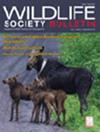Duck hunters and difficulty complying with harvest regulations
IF 1.5
4区 环境科学与生态学
Q3 Environmental Science
引用次数: 0
Abstract
Due to the steady decline of duck hunter participation, several studies have investigated means to bolster the duck hunter population. Researchers and wildlife professionals have assumed that simpler regulations would attract new and unconfident hunters to participate in duck hunting. In light of this, we sought to identify what portion of the duck-hunting population had difficulty understanding species-specific bag limits or complying with species-specific bag limits in the field. We also sought to describe hunters who had difficulty complying with specific bag limits and how their difficulties were associated with elements related to demography, attitude, and behavior. We found most hunters had no difficulty understanding (82%) or complying with (74%) species specific bag limits, but flyway (χ2 = 35.06, P < 0.01), number of ducks harvested (χ2 = 9.76, P < 0.01), number of years hunted (χ2 = 9.20, P < 0.01), and gender (χ2 = 4.14, P < 0.05), were important to predicting hunter difficulty with compliance. Hunters who can overcome their difficulties understanding and complying with species-specific bag limits may be more likely to be integrated into the duck hunting culture, and more likely to continue duck hunting in the future. More species identification tools and fewer species-specific bag limits may be appropriate for the 18% of the duck hunter population who indicated that bag-specific regulations were difficult to understand and the 26% who indicated that it was difficult to comply with species-specific bag limits in the field. A closer look may be warranted for how the trade-offs associated with the combination of species-specific bag limits in combination with the variety of duck season zone and split options states employ, license/stamp requirements, area-specific regulations, and trespass laws may influence duck hunter experiences.

鸭子猎人和遵守收获规定的困难
由于猎鸭人的参与率持续下降,一些研究调查了如何提高猎鸭人数量的方法。研究人员和野生动物专业人士认为,更简单的规定可以吸引新的和缺乏自信的猎鸭人参与猎鸭。有鉴于此,我们试图确定哪一部分猎鸭人在理解特定物种的袋数限制或在野外遵守特定物种的袋数限制方面存在困难。我们还试图描述那些在遵守特定袋数限制方面有困难的猎人,以及他们的困难与人口、态度和行为等相关要素之间的关系。我们发现,大多数猎人在理解(82%)或遵守(74%)物种特定袋数限制方面没有困难,但在航道(χ2 = 35.06, P < 0.01)、收获鸭子数量(χ2 = 9.76, P < 0.01)、狩猎年数(χ2 = 9.20, P < 0.01)和性别(χ2 = 4.14, P < 0.05)对预测猎人的遵从困难非常重要。能够克服困难理解和遵守特定物种数量限制的猎人可能更容易融入猎鸭文化,也更有可能在未来继续猎鸭。18%的猎鸭人表示难以理解特定物种的袋数限制规定,26%的猎鸭人表示在野外难以遵守特定物种的袋数限制规定,对于这部分人来说,增加物种识别工具和减少特定物种的袋数限制可能是合适的。可能需要更仔细地研究特定物种的袋数限制与各州采用的各种鸭季区域和分区选择、许可证/印章要求、特定区域法规和非法入侵法律的结合如何影响猎鸭人的体验。
本文章由计算机程序翻译,如有差异,请以英文原文为准。
求助全文
约1分钟内获得全文
求助全文
来源期刊

Wildlife Society Bulletin
BIODIVERSITY CONSERVATION-
CiteScore
2.10
自引率
13.30%
发文量
0
期刊介绍:
The Wildlife Society Bulletin is a journal for wildlife practitioners that effectively integrates cutting edge science with management and conservation, and also covers important policy issues, particularly those that focus on the integration of science and policy. Wildlife Society Bulletin includes articles on contemporary wildlife management and conservation, education, administration, law enforcement, and review articles on the philosophy and history of wildlife management and conservation. This includes:
Reports on practices designed to achieve wildlife management or conservation goals.
Presentation of new techniques or evaluation of techniques for studying or managing wildlife.
Retrospective analyses of wildlife management and conservation programs, including the reasons for success or failure.
Analyses or reports of wildlife policies, regulations, education, administration, law enforcement.
Review articles on the philosophy and history of wildlife management and conservation. as well as other pertinent topics that are deemed more appropriate for the Wildlife Society Bulletin than for The Journal of Wildlife Management.
Book reviews that focus on applied research, policy or wildlife management and conservation.
 求助内容:
求助内容: 应助结果提醒方式:
应助结果提醒方式:


